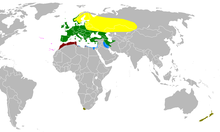Common chaffinch
| Common chaffinch | |
|---|---|
 |
|
| Male in Hessen, Germany | |
 |
|
| Female in Hessen, Germany
Song of male in Surrey, England
|
|
| Scientific classification | |
| Kingdom: | Animalia |
| Phylum: | Chordata |
| Class: | Aves |
| Order: | Passeriformes |
| Family: | Fringillidae |
| Subfamily: | Fringillinae |
| Genus: | Fringilla |
| Species: | F. coelebs |
| Binomial name | |
|
Fringilla coelebs Linnaeus, 1758 |
|
 |
|
| Distribution map Summer Resident Winter Introduced canariensis spodiogenys |
|
The common chaffinch (Fringilla coelebs), usually known simply as the chaffinch, is a common and widespread small passerine bird in the finch family. The male is brightly coloured with a blue-grey cap and rust-red underparts. The female is much duller in colouring but both sexes have two contrasting white wings-bars and white sides to the tail. The male bird has a strong voice and sings from exposed perches to attract a mate.
The chaffinch breeds in much of Europe, across Asia to Siberia and in northwest Africa. The female builds a nest with a deep cup in the fork of a tree. The clutch is typically 4–5 eggs, which hatch in about 13 days. The chicks fledge in around 14 days but are fed by both adults for several weeks after leaving the nest. Outside the breeding season chaffinches form flocks in open countryside and forage for seeds on the ground. During the breeding season they forage on trees for invertebrates, especially caterpillars, and feed these to their young. The chaffinch is a partial migrant; birds breeding in warmer regions are sedentary while those breeding in the colder northern areas of its range winter further south.
The eggs and nestlings of the chaffinch are taken by a variety of mammalian and avian predators. Its large numbers and huge range mean that chaffinch is classed as of least concern by the International Union for Conservation of Nature.
The chaffinch was described by Linnaeus in 1758 in the 10th edition of his Systema Naturae under its current binomial name.Fringilla is the Latin word for a finch while caelebs means unmarried or single. Linnaeus remarked that during the Swedish winter, only the female birds migrated south through Belgium to Italy.
The English name comes from the Old English ceaffinc, where ceaf is "chaff" and finc "finch". The chaffinch is one of the many birds depicted in the marginal decoration of the 15th century English illuminated manuscript the Sherborne Missal. The English naruralist William Turner described the chaffinch in his book on birds published in 1544. Although the text is in Latin, Turner gives the English name as chaffinche and lists two folk names: sheld-appel and spink. The word sheld is a dialectal word meaning pied or multicoloured (as in Shelduck). Appel may be related to Alp, an obsolete word for a bullfinch. The name spink is probably derived from the bird's call note. The names spink and shell apple are among the many folk names listed for the chaffinch by Reverend Charles Swainson in his Provincial Names and Folk Lore of British Birds (1885).
...
Wikipedia

